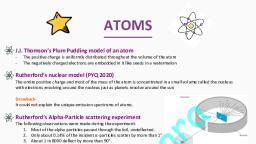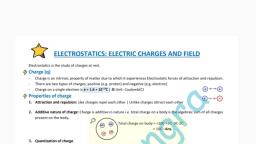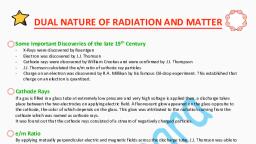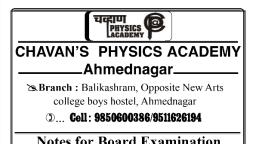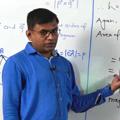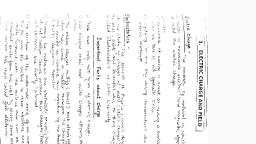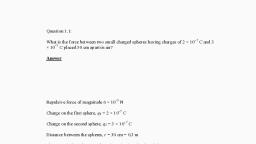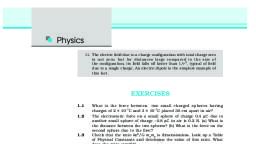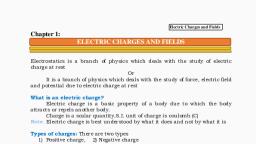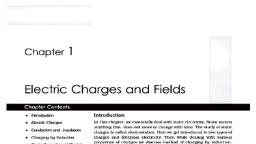Page 1 :
ER. ANIL JANGRA, ELECTROSTATICS: ELECTRIC CHARGES AND FIELD, Electrostatics is the study of charges at rest., 5 Charge (q), Charge is an intrinsic property of matter due to which it experiences Electrostatic forces of attraction and repulsion., There are two types of charges; positive (e.g. proton) and negative (e.g. electron), Charge on a single electron is e = 1.6 x 101°C | SI Unit- Coulomb(C), 4 Properties of charge, 1. Attraction and repulsion: Like charges repel each other | Unlike charges attract each other, 2. Additive nature of charge: Charge is additive in nature i.e. total charge on a body is the algebraic sum of all charges, present on the body., Total charge on body = +10C +5C -3C-2C, = 10C -Ans., 3. Quantisation of charge, Charge on a body is the integral multiple of charge on a single Electron., i.e. Q= ne, (Where e is the charge on a single electron and n= 1, 2, 3.), Ques: Calculate the no. of electrons in 1C charge, Ans: q= ne; 1= n x 1.6x1019., ;,n= 6.25 x 1018 electrons., REST, 4. Invariability of charge, Charge is invariable in nature i.e. the charge on a body does not depend on its state of rest or motion., 5 Principle of conservation of charge, 'In an isolated system, charge can neither be created nor destroyed', Note: If a body has excess electrons, it has a negative charge., If a body has excess protons, it has a positive charge., 4 Methods of charging bodies, 1. Charging bodies by rubbing/friction, When two bodies are rubbed together, the friction between the bodies causes transfer of electrons from one body, to another and as a result both bodies become charged. The body which loses electrons becomes positively charged, and the body which gains electrons becomes negatively charged., Eg - rubbing glass rod with silk, rubbing plastic rod with fur, rubber, Silk thread, Silk thread, Silk thread, Glass rod, Plastie rod, Glass rod, rod, rod, Plastie, Plastic rod, (a), Ib, (c), By convention, charge on glass rod and fur is positive and charge on silk cloth and plastic rod is negative.
Page 2 :
ER. ANIL JANGRA, 2. Charging by touch, When a charged body is made to touch an uncharged body, some of the charge from the charged body is, transferred to the other body. This is called charging by touch., 3. Charging by induction, Let us understand charging by induction through an example., Take two metallic spheres A and B (mounted on insulating stands) and bring them together., Now, bring a positively charged rod near the left end of sphere A (not touching)., The positive charge of the rod attracts the electrons of A as a result there is an excessive negative charge on left side, of A. At the same time, there is an accumulation of excessive positive charge on right side of sphere B due to, repulsive forces., So, we see that at the end of this process, both spheres become charged. This process of charging is called charging, by induction., Note: 1. Charges on both spheres will be equal and opposite., 2. Not all the electrons in the sphere accumulate on one side because as electrons keep getting accumulated, the, incoming electrons, a strong force of repulsion from the already accumulated electre, Over time equilibrium is, set up under the force of attraction of the rod and force of repulsion of the electrons., A, A, A, в, в, 4 Gold leaf Electroscope, -Brass di sc, Used to detect charge on a body., -Insulator plug, Working: when a charged body is brought near or touched with, the metal knob, charge travels to the leaves through the rod., Since both the leaves have the same charge they diverge(repel), -Brass rod, Glass bottle, The degree of divergence is an indicator of amount of charge., Gold leaves-, -Metal foil, Earth
Page 3 :
ER. ANIL JANGRA, 5 Coulomb's Law, (PYQ 2019, 2014, 2011), The magnitude of electrostatic force between two point objects is directly proportional to the product of the two, charges and inversely proportional to the square of the distance between them and acts along the line joining their, centres., 1, F =, 4 n Eo, r2, PERMITTIVITY OF FREE SPACE (8), E =8.85x1012 C?N'm2, PERMITTIVITY IN MEDIUM (8), There exists a relation between permittivity in free space/vacuum and that in a medium., &r = K = ɛ/ɛ, where &, is the relative permittivity of medium AKA K ( dielectric constant of medium), Ques: Plot a graph showing variation of coulomb force (F) versus 1/r2, where r is the distance between the two charges, of each pair of charges A(1µC,2µC) and B (1µC, -3µC) (PYQ 2011), sol": We know Foc 1/r2, therefore,, Similar PYQS, ques: A thin metallic spherical shell of radius R, carries a charge Q on its surface. A point charge, Q/2 is placed at its center C and another charge, +2Q is placed at a distance x from the center., Find force on the charge Q/2 and 2Q. (PYQ 2015), Hint: field, inside shell is, Since Fc q192, graph for pair B will have greater slope, Than slope of pair A., zero, 5 Force between multiple charges, Principle of superposition, Principle of superposition talks about two things, 1. Net force on any charge is the vector sum of all the forces acting on that charge, 2. The individual forces between two charges are unaffected due to the presence of other charges, lal
Page 4 :
ER. ANIL JANGRA, Ques: Example 1.6 Consider three charges q,. q,, q, each equal to q at the, vertices of an equilateral triangle of side 1. What is the force on a, charge Q (with the same sign as q) placed at the centroid of the, triangle, as shown in Fig. 1.9?, D, 1., Sol": In AABC, we can calculate,, AO=BO=CO= /2 ÷ cos30 = 1/v3, Now, let us calculate the forces between the three charges at the vertices and charge Q at the centroid individually, (principle of superposition), F1 =3kq,Q/l(-j), F2= 3kq,Q/I? (sin60î + cos60j), F3= 3kq.Q/l? (-sin60î + cos60j), Now to calculate net force on Q we find the vector sum of the forces F1 + F2 + F3 which amounts to zero., We can also see by symmetry that net force on Q is zero., 4 Electric Field, Electric field can be defined as the space around a charge in which another charge experiences an electrostatic force of, attraction and repulsion. An electric charge Q produces an electric field 'everywhere' in its surrounding., Electric field strength/ field intensity (E), Electric field strength at a point is defined as the force that a unit charge experiences when kept at that point., Mathematically , lim q->0 E=F/q, It is a vector quantity | SI Unit- N/C or V/m, General expression for field strength:, Q, Let us take a charge Q. at a distance r from it, there is another unit charge q. the force on q due to Q can be written, as-, F = k Q.q/r?, E = F/q, E = k Q/r?, Note: Electric field strength also follows law of superposition i.e. net electric field strength at a point is the vector, sum of all field strengths due to individual charges.
Page 5 :
ER. ANIL JANGRA, Characteristics of Electric field, 1. Electric field at a point doesn't depend on charge q as the ratio F/q is independent of q., 2. For a positive point charge electric field is directed radially outwards., 3. For a negative point charge electric field is directed radially inwards., 4. Magnitude of E due to a charge Q depends inversely on R?, so at equal distances from the charge Q, E will have same, magnitude i.e. it shows radial symmetry., Ques: A charge is uniformly distributed over a ring of radius a. Obtain an expression for the electric field at its center., Hence show that for large distances it behaves like a point charge. (PYQ 2016), Ans., Consider a differential, Element of length dl, And charge dq, de cne, dg = idl, dE, Qd, ) Field along x-axis, > Ex =, 4x TE, (d + a), dE= dEcos0, Field along y-axis, dg, dE =, 4, NE, a'+d, cos 0, (Due to symmetry), 1, dE =, idl, Qd, >E =, a' +d Va +d, 4 x TE,, 4X ne,, (d' + a')", d, 3/2, di, So, field at center, 4 x Re., (d² +a*), E = o, Qd, 2х ла, 2x na, (d +a"), Similar PYQS, An electron falls through, 2.0 x 104 N/C (Fig, a), distance of 1.5 em in a uniform electric field of magnitude, + ++ + + +, (a), Calculate the time it takes to fall through this distance starting from rest., PYQ 2013 CAm2.1x l0), 4 Electric Field lines (PYQ 2020,2019,2018,2017,2016,2015,2014,2013,2012,2011,2010), The concept of electric field lines was given by Faraday to visualise the strength of electric fields., Electric field lines are imaginary, straight or curved lines around charged bodies such that tangent to it at a point, gives direction of electric field at that point., Properties of Electric Field lines, 1. Field lines originate from a positive charge and terminate at a negative charge.













